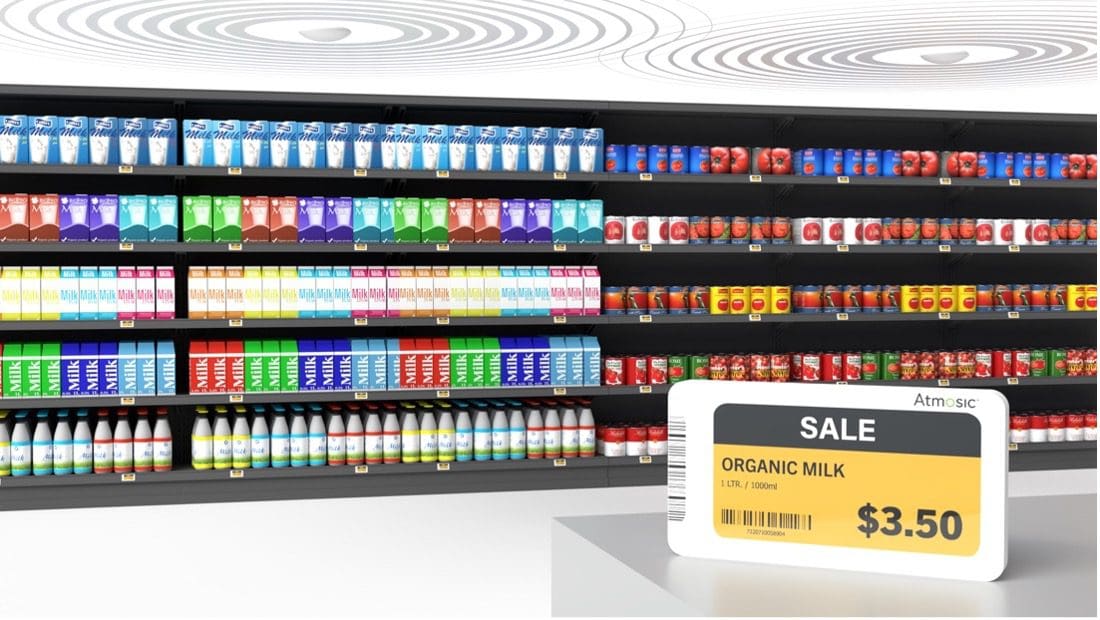How Atmosic Enables Maintenance-Free ESLs With AirFuel RF Wireless Power
The next generation of RF wireless power is here and Atmosic is delivering it to the retail environment with the help of AirFuel RF technology. Atmosic is a leading provider of ultra-low-power, wireless chips, striving to reduce IoT battery waste problems by enabling batteries to last the full lifetime of a device and, in some cases, allow a device to operate without any batteries. By re-architecting wireless connectivity solutions from the ground up, they are breaking the power barrier to widespread IoT adoption.
Their portfolio of wireless devices with built-in power management capabilities and energy harvesting makes them a prime beneficiary of AirFuel RF wireless power technology which uses radio frequencies (RF) to enable power transfer to multiple devices simultaneously without contact and up to several meters away. Identifying an opportunity to improve the functionality and benefits of electronic shelf labels (ESLs), Atmosic implemented the standards-driven AirFuel RF standard to bring battery-free, maintenance-free IoT technology to the retail environment.
The Challenge: Harvesting Energy to Implement Maintenance-Free ESLs
IoT environments can be rich in harvestable energy, a perk that is useful for powering IoT devices while reducing the need and our dependence on both batteries and the ecological problems they create. However, while many IoT devices are created to operate using very little power, they are not created with energy conservation as a primary objective.
However, indoor environments are well suited to benefit from this new approach to RF wireless power that can be used for both powering and charging IoT devices such as ESLs used in retail stores. ESLs allow stores to display information in real-time, making it easy to change prices on the fly and advertise different promotions and loyalty programs. Companies could even offer shoppers a more personalized shopping experience by targeting them with promotions specific to their interests and buying history. Overall, ESLs help stores to streamline operations, respond faster to market shifts, and also reduce operating costs (just think of all the time and labor it takes to update paper signage across a store).

Atmosic sought to enable large fleets of ESLs for use in retail stores, along with other applications, that were effectively maintenance-free for their lifespan once deployed.
The Solution: Using AirFuel RF to Direct ESL Energy On-Demand
Atmosic turned to AirFuel RF wireless charging technology for a ground-up approach that integrated multiple aspects of an IoT design into one ESL solution, facilitated by next-generation power-at-a-distance.
Atmosic’s energy-saving technologies use common methods to optimize digital circuits and implement them in analog along with an integrated PMU which can be configured with energy profiles that optimize performance. By implementing this technology, companies can enable ambient energy to be used “on-demand” by the core wireless SoC function or for storage for future use.
Integrating energy harvesting in ESLs provided an opportunity not only to simplify the developer experience, ensuring that any harvested power was maximized but also allows them to provide customers with a maintenance-free ESL that saves time, money, and resources.
The Results: Streamlining Inventory Management to Save Time, Money & Waste
Ultimately, the AirFuel RF wireless power standard enables warehouses and retail establishments to gain valuable inventory management without the need to interact physically with any sensor or ESL device. Once a tag is presented, the infrastructure powers the device directly. On the backend, retailers can push the limits of automation without worrying about long-term power use. Meanwhile, consumers can experience a more straightforward, personalized, and immersive shopping experience, and the benefits don’t end there.

Batteries are hazardous waste. According to the EPA, every year in the United States, millions of single-use and rechargeable batteries are bought, used, and disposed of in the trash, typically ending up in a landfill. They can contain metals such as mercury, lead, cadmium, nickel, and silver, which can pose a threat to human health or the environment when improperly managed at the end of their life. When a battery enters a landfill, the casing can be crushed or easily degraded, causing toxins to leach into the environment.
By embracing wireless power technology, we can eliminate battery usage. With more than 27 billion loT-connected devices expected by 2025, companies have an incredible opportunity to increase awareness of their carbon footprint and embrace product decisions that lead to a cleaner, more sustainable future.
It’s no surprise that developers worldwide are hungry for these clean alternatives. Nick Dutton, Senior Director of Product Marketing at Atmosic Technologies explains,
“This new standard for wireless charging and wireless power is a huge step forward for ESL adoption, offering a reliable way to control the transmitted power to the ESL and ensure energy isn’t wasted. All in all, the AirFuel protocol is a win-win-win scenario: there is a reduction in batteries that end up in landfill is good for the environment, lower maintenance costs and resources are a big benefit for retailers, and customers can enjoy a better shopping experience.”
Working Together to Create a Wire-Free World
AirFuel Alliance® enables companies to provide cutting-edge wireless power and wireless charging experiences for their customers. Members bring wireless power solutions to market today and champion ongoing wireless technology innovation. They also receive access to the world’s leading wireless charging standards and development tools, and connect to a global community of companies working together to realize a vision of a world without wires.
Become a member of AirFuel Alliance, or attend our AirFuel Certified Engineering course to fast-track your integration of AirFuel wireless charging technology.
